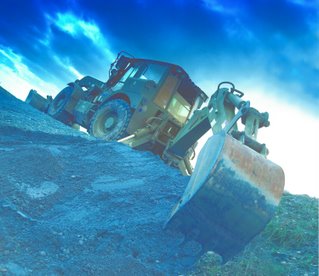


|

|
|
|
Home |
The Mil & Aero Blog
 Posted by John Keller Vetronics coverage in publications like ours usually involves the big, powerful, complicated stuff like the M-1 Abrams main battle tank and the M109 self-propelled howitzer. You can hardly blame us; not only do these vehicles have advanced electronics, but they make a lot of noise, fire, and smoke. What could be more compelling? Sometimes we cover the less exciting vehicles and their electronic systems. Today's lead story, for example, concerns the new Medium Mine Protected Vehicle (MMPV), which is designed to withstand blasts from improvised explosive devices. Rarely, however, does our vetronics coverage extend to armored vehicles like the combat earth mover, and for this omission we freely acknowledge our negligence. Usually only military branches like the Army Engineers and the Navy Seabees learn much about combat construction vehicles, but I recently stumbled over this story that I have to share. It's about the High Mobility Engineer Excavator (HMEE) from JCB Inc. in Pooler, Ga., which is set for duty in Iraq and Afghanistan. I can see how we might overlook a combat vehicle like this, since its most sophisticated vetronics is limited essentially to its ABS braking technology and computer diagnostics. Its vetronics, however, is not the most notable aspect of the MMPV. I'll tell you what is ... ... this is a backhoe that can go 60 miles an hour, not only on paved roads but cross country as well. If you don't believe me, take a look at the accompanying video, which features a drag race between the HMEE and a civilian backhoe. The race isn't even close, and it's easy to see why JCB has won a $209 million U.S. Army contract to build 800 of these armored construction vehicles for front-line duty. Any kidding aside, combat vehicles like this -- believe it or not -- in the near future could become important weapons against terrain-following cruise missiles, which are programmed to follow known land features as guides to their targets. When we think about missile defense, what most quickly comes to mind? Laser defenses, electronic jammers, even air-to-air missiles. What happens, however, if those defenses either cannot be brought to bear, or would be ineffective? Think outside the box. Need to spoof a terrain-following missile? How about changing the terrain? In those terms, what better weapon would we have than an HMEE that's able to lift more than 2.2 tons, dig a depth of almost 13 feet, and move as fast as 60 miles an hour in battlefield conditions? Get rid of a little hill here, add another one there, and dig some curvey trenches that look like gullies and you could have a bunch of very confused cruise missiles. Sometimes perhaps the low-tech approach might be best. It's worthwhile to think about that once in a while. 0 Comments:
<< Home |
Welcome to the lighter side of Military & Aerospace Electronics. This is where our staff recount tales of the strange, the weird, and the otherwise offbeat. We could put news here, but we have the rest of our Website for that. Enjoy our scribblings, and feel free to add your own opinions. You might also get to know us in the process. Proceed at your own risk. 
John Keller is editor-in-chief of Military & Aerospace Electronics magazine, which provides extensive coverage and analysis of enabling electronic and optoelectronic technologies in military, space, and commercial aviation applications. A member of the Military & Aerospace Electronics staff since the magazine's founding in 1989, Mr. Keller took over as chief editor in 1995.  Courtney E. Howard is senior editor of Military & Aerospace Electronics magazine. She is responsible for writing news stories and feature articles for the print publication, as well as composing daily news for the magazine's Website and assembling the weekly electronic newsletter. Her features have appeared in such high-tech trade publications as Military & Aerospace Electronics, Computer Graphics World, Electronic Publishing, Small Times, and The Audio Amateur.
Courtney E. Howard is senior editor of Military & Aerospace Electronics magazine. She is responsible for writing news stories and feature articles for the print publication, as well as composing daily news for the magazine's Website and assembling the weekly electronic newsletter. Her features have appeared in such high-tech trade publications as Military & Aerospace Electronics, Computer Graphics World, Electronic Publishing, Small Times, and The Audio Amateur.
 John McHale is executive editor of Military & Aerospace Electronics magazine, where he has been covering the defense Industry for more than dozen years. During that time he also led PennWell's launches of magazines and shows on homeland security and a defense publication and website in Europe. Mr. McHale has served as chairman of the Military & Aerospace Electronics Forum and its Advisory Council since 2004. He lives in Boston with his golf clubs.
John McHale is executive editor of Military & Aerospace Electronics magazine, where he has been covering the defense Industry for more than dozen years. During that time he also led PennWell's launches of magazines and shows on homeland security and a defense publication and website in Europe. Mr. McHale has served as chairman of the Military & Aerospace Electronics Forum and its Advisory Council since 2004. He lives in Boston with his golf clubs.
Previous Posts
Archives
|
|||||
Internet gems
THE MAE WEBSITE AUTHORS ARE SOLELY RESPONSIBLE FOR THE CONTENT AND ACCURACY OF THEIR BLOGS, INCLUDING ANY OPINIONS THEY EXPRESS, AND PENNWELL IS NOT RESPONSIBLE FOR AND HEREBY DISCLAIMS ANY AND ALL LIABILITY FOR THE CONTENT, ITS ACCURACY, AND OPINIONS THAT MAY BE CONTAINED HEREIN. THE CONTENT ON THE MAE WEBSITE MAY BE DATED AND PENNWELL IS UNDER NO OBLIGATION TO PROVIDE UPDATES TO THE INFORMATION INCLUDED HEREIN.
|
||||||
|
|
Home | About Us | Contact Us | Corporate Website | Privacy Policy | Courage and Valor Foundation | Site Map
Also Visit: Laser Focus World | Vision Systems Design | Industrial Laser Solutions Copyright © 2007: PennWell Corporation, Tulsa, OK; All Rights Reserved. | Terms & Conditions | Webmaster |